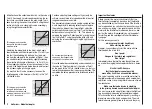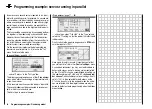
85
del data, it is worthwhile thinking carefully about a sen-
sible layout of the transmitter controls.
If the model in question is one with the emphasis on “po-
wer” – whether the power of an electric motor or inter-
nal combustion engine – you will probably encounter few
problems in this matter, because the two stick units are
primarily employed to control the four basic functions
“power control (= throttle)”, “rudder”, “elevator” and “aile-
ron”. Nevertheless, you still have to call up the ...
»Base settings«
menu (page 38 … 41)
… and defi ne your preferred throttle direction, i.e. thrott-
le minimum forward (“Idle front”) or back (“Idle rear”), be-
cause the program’s default setting is “no” (i.e. no motor)
when you fi rst set up a model memory.
The basic difference between “none” and “throttle min.
front / rear” is the effect of the C1 trim. The trim is ef-
fective over the full stick travel if “none” is entered, but it
only affects the idle range if you enter “throttle min. front
or rear”. However, it also affects the “direction of effect”
of the C1 stick, i.e. if you switch from “front” to “rear” or
vice versa, you do not also have to reverse the direction
of the throttle servo. For safety reasons you will also see
a warning message if you switch the transmitter on with
the throttle stick positioned towards “full-throttle” – but
only if you have already set “throttle min. front or rear”.
Your choice of “none” (no motor) or “throttle min. front
or rear” also affects the range of mixers available in the
»
Wing mixers
« menu. The mixers “Brake
NN” are
only present if you choose “none” (no motor), otherwise
they are suppressed.
In addition to these basic matters you will certainly need
to consider carefully how best to control any “auxiliary
functions” featured on your model.
In contrast, if your model is a glider or electric glider the
whole situation may be rather different. The immediate
question is: what is the best way of operating the motor
and braking system? Now, some solutions have proved
to be practical, and others less so.
For example, it is not a good idea to be forced to let go
of one of the primary sticks in order to extend the airbra-
kes or deploy the crow braking system when your glider
is on the landing approach. It surely makes more sense
to set up switchable functions for the C1 stick (see ex-
ample 4 on page 92), or to assign the braking system
to the throttle stick, and shift the motor control to a sli-
der – or even a switch. With this type of model the elec-
tric motor is often little more than a “self-launching sys-
tem”, and is used either to drag the model into the sky at
full power, or to pull it from one area of lift to the next at,
say half-power, and for such models a throttle switch is
usually quite adequate. If the switch is positioned whe-
re you can easily reach it, then you can switch the motor
on and off without having to let go of the sticks – even
on the landing approach.
Incidentally, similar thinking can be applied to fl ap cont-
rol systems, regardless of whether they are “just” the ai-
lerons, or full-span (combination) control surfaces which
are raised and lowered in parallel.
Once you are satisfi ed that all these preparations have
been completed successfully, programming can begin.
Programming examples: Fixed-wing model
Summary of Contents for MX-16S
Page 1: ...1...
Page 17: ...17...
Page 31: ...31 Fixed wing models Installation and connections...
Page 35: ...35 Program description Reserving a new memory...
Page 47: ...47 Base settings Model helicopter...
Page 83: ...83 Fail safe...
Page 89: ...89 Programming examples Fixed wing model...
Page 109: ...109 Programming examples Model helicopter...
Page 112: ...112 112...
Page 116: ...116...
















































